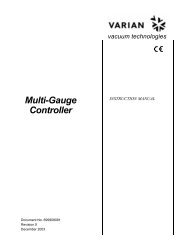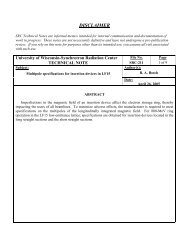SRC Users' Meeting - Synchrotron Radiation Center - University of ...
SRC Users' Meeting - Synchrotron Radiation Center - University of ...
SRC Users' Meeting - Synchrotron Radiation Center - University of ...
You also want an ePaper? Increase the reach of your titles
YUMPU automatically turns print PDFs into web optimized ePapers that Google loves.
Ag surface state such that it moves above the Fermi level and becomes depopulated and<br />
significantly less intense [2].<br />
Figure 2 shows the in-plane dispersion <strong>of</strong> the quantum well states and the surface state<br />
along the - K direction for a 22 ML thick Ag film. The bottom <strong>of</strong> the Ag surface state band is<br />
26 meV above the Fermi level. A fit<br />
Figure1<br />
Figure2<br />
7.5<br />
hv=22eV<br />
Ag on Au/Si- root3<br />
0.0<br />
Ag 22Ml Au/Si<br />
n=1<br />
7.0<br />
-0.2<br />
Photoemission Intensity (arb.units)<br />
6.5<br />
6.0<br />
5.5<br />
Ag ML<br />
22<br />
19<br />
16<br />
14<br />
12<br />
Initial state energy (eV)<br />
-0.4<br />
-0.6<br />
-0.8<br />
-1.0<br />
n=2<br />
n=3<br />
5.0<br />
10<br />
8<br />
-1.2<br />
n=4<br />
-3 -2 -1 0<br />
Initial state energy (eV)<br />
6<br />
-1.4<br />
-0.3 -0.2 -0.1 0.0 0.1 0.2 0.3<br />
k || (A -1 )<br />
to the data (solid curve) reveals the effective mass m*/m <strong>of</strong> the surface state band to be 0.404<br />
which is very close to the value 0.397 measured by F. Reinert et al [3] from the (111) surface <strong>of</strong><br />
bulk Ag. The dispersions <strong>of</strong> the quantum well states (crosses) can be compared with those <strong>of</strong> Ag<br />
bulk bands calculated at constant k (triangles) [4]. The match between the measurement and<br />
calculation is good for the quantum-well states with quantum numbers n from n = 2 to n = 4. For<br />
the quantum-well state with n = 1, the dispersion is significantly less than that <strong>of</strong> the other<br />
quantum well states and corresponding calculated bulk value. We note that the deeper quantumwell<br />
states overlap the bulk bands in the substrate and so are really resonances; for such states<br />
the reflection phase shift at the interface is relatively slowly-varying and so the dispersions in<br />
Fig. 2 are approximately at constant k . In contrast, the energy <strong>of</strong> the n = 1 state is within the<br />
energy gap <strong>of</strong> the substrate, where the interface phase shift is rapidly varying. In this case, the<br />
dispersion in Fig. 2 includes an implicit variation in k so that the curvature may not reflect the<br />
true effective mass. Further analysis <strong>of</strong> the dispersions and effective masses <strong>of</strong> quantum well<br />
states from different other coverages will be done.<br />
This work is supported by the U.S. National Science Foundation (grant DMR-02-03003).<br />
We acknowledge the Petroleum Research Fund, administered by the American Chemical<br />
Society, and the U.S. Department <strong>of</strong> Energy, Division <strong>of</strong> Materials Sciences (grant DEFG02-<br />
91ER45439), for partial support <strong>of</strong> the synchrotron beamline operation and the central facilities<br />
<strong>of</strong> the Frederick Seitz Materials Research Laboratory. The <strong>Synchrotron</strong> <strong>Radiation</strong> <strong>Center</strong> <strong>of</strong> the
















